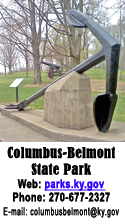|
Lt. Commander Charles W. Flusser
was one of Kentucky’s most noble sons
By BRYAN BUSH
Bugle Staff Writer
When South Carolina seceded from the Union on Dec. 20, 1860, many of Charles Williamson Flusser’s fellow officers thought he may enlist in the Confederate army.
The native of Annapolis, Md., who grew up in Kentucky, thought differently, however.
An 1853 graduate of the U.S. Naval Academy, Flusser refused an offer of high command in the Confederate service and instead remained in the U.S. Navy. But his two brothers (Ottokar and Guy) did join the Confederacy. Ottokar joined the 4th Texas Infantry and Guy joined the 4th Kentucky Cavalry.
In early 1861, Charles Flusser became commandant of the Naval Academy. When the War Department worried Maryland may join the Confederacy, Flusser was ordered to move the school’s students and instructors to Newport, R.I. By the fall of 1861, Flusser was no longer an instructor at the Naval Academy, but a commander of a gunboat, performing blockade duty off the coast of Georgia. Commodore Louis Goldborough assigned Flusser to the Burnside Expedition and he took command of the gunboat Commodore Perry. He assisted in the attack of Roanoke Island, N.C., which the Confederates surrendered on Feb. 8, 1862. On Feb. 10, Flusser played a leading role in the Union victory at the Battle of Elizabeth City. He spent most of this time in the waters off the eastern coast of North Carolina and southeastern Virginia.
While serving on the Commodore Perry, he learned of the death of his brother, Ottokar, at the Battle of Antietam in 1862. Flusser’s mother had the body brought back to Kentucky and Ottokar was buried at Cave Hill Cemetery on Sept. 19.
On Oct. 3, Flusser had command of a small fleet, consisting of the Commodore Perry, Hunchback and Whitehead. His fleet advanced up the Chowan and Blackwater Rivers to within less than a half mile of Franklin, Va., and 20 miles west of Suffolk. His fleet came under heavy fire from the Confederate forces that were posted on a high embankment. Flusser’s fleet shelled the town of Franklin for more than three hours. He was promised the cooperation of a land force from Suffolk, which never materialized, and without infantry support and the threat of the capture of his ship, Flusser’s fleet withdrew. He had four men killed and 17 wounded. But, because of his actions during the battle of Franklin, the commander earned the nickname of “Lion-hearted Flusser.”
In May 1863, Flusser took command of the USS Miami, which was the flagship of his squadron. By April 1864, Flusser’s squadron, comprised of the USS Miami, USS Southfield, USS Whitehead and USS Ceres, was sent to Plymouth, N.C. to hold the Union position on the North Carolina coast. In 1862, Union forces had managed to capture Plymouth and several other positions along the North Carolina coast. Union forces prevented the Confederacy from several ports of entry, which were used for blockade running and imports of food from several different countries.
In the spring of 1864, the Confederate War Department decided to try and take back the Union-held ports, including Plymouth. Gen. George Pickett led a division to the area and launched a failed attack on New Bern in February and Gen. Robert Hoke moved his army against Plymouth. Hoke planned his attack using the CSS Albemarle, which was an ironclad ram that was still being built on the Roanoke River inland from Plymouth. On April 17, Hoke’s 7,000 men attacked Union Gen. Henry Wessells’ 2,800 men at Plymouth and captured some of the outer defenses, but Hoke needed the Albemarle to shell the city and Union forts from the river.
Confederate Capt. James Cooke moved the Albemarle down the Roanoke River and when the vessel arrived at Plymouth, he was confronted by Flusser’s Miami and the Southfield. The Miami and Southfield were lashed together and Flusser hoped to catch the Albemarle between his two ships and pulverize the ram with his larger guns. Cook did not fall into Flusser’s trap, however, and instead decided to ram the Southfield. Within two minutes of the sighting, the Albemarle rammed the Southfield and fired a round that produced a huge gash in the hull causing the ship to sink quickly.
Flusser ordered both of his ships to fire their 100-pound Parrott rifles and the 11-inch Dahlgren cannons. Flusser fired the first three shots personally from the Miami, and, on the third firing, he loaded the Dahlgren gun with a shell equipped with a 10-second time fuse. The shell struck the ironclad, rebounded, and killed Flusser instantly at the gun, with one piece cutting out his heart.
The Kentuckian still was holding the lanyard of his gun when his body fell on the deck of his ship. The Southfield sunk in less than five minutes.
The Miami cast loose and the Albemarle tried to pierce the Miami, so the ship had no choice but to back down the river. The Ceres took Flusser’s body to Roanoke Island. With the Albemarle controlling the Roanoke River, she began to fire at the Union forts. Hoke’s cannons fired at the city of Plymouth and the 85th Redoubt. The Union Fort Williams and Battery Worth fired at the Albemarle with no effect. The cannon balls simply bounced off her hull. Hoke moved his men from Fort Gray to Wessells’ right. A large Confederate force crossed Coneby Creek below the town and massed their army on Wessells’ left. On April 20, Wessells’ right and front were threatened by the Confederates and advanced against his left and attacked, carrying the entire line, penetrating the town, and capturing Battery Worth. Gen. Wessells was surrounded and Confederate forces shelled Fort Williams from four different directions. At 10 a.m., Wessells surrendered.
During the Battle of Plymouth, the Confederates had 163 men killed and 554 wounded, but captured the entire Union garrison and a huge amount of supplies and arms. Union forces had 150 killed and wounded, while several hundred Union soldiers eventually died at Andersonville, the Confederate prisoner of war camp.
When news reached the high command that Flusser was killed in action, an outpouring of sorrow from his superior officers was communicated in the after-action reports. Major Gen. John Peck wrote that the Union forces lost a “noble sailor and gallant patriot.” Wessells, commanding the Union forces at Plymouth, wrote that Flusser was “one of Kentucky’s most noble and chivalrous sons.” He wrote that “in the death of this accomplished sailor, the Navy has lost one of its brightest ornaments and he will long be remembered by those who knew him and loved him for his intellectual worth, his social qualities and manly bearing.”
On June 9, 1864, Lt. Guy Flusser was killed at the Battle of Mount Sterling. His body was transported to Cave Hill Cemetery and on July 2, 1864, he was buried on top of his brother Ottokar and his brother Charles.
There is some mystery, however, surrounding Charles W. Flusser’s body. According to the United States Naval Academy, Flusser’s body was originally interred at the military cemetery in New Bern, but in 1868, the Navy transferred his remains to the U. S. Naval Academy cemetery. He is buried in Section 7, Lot 1591, but according to Cave Hill Cemetery’s records, the official government undertaker, Washington Wyatt, buried Charles Flusser on April 21, 1864, in Section M, Lot 4.
|













